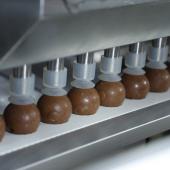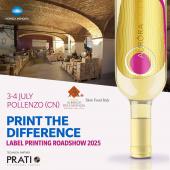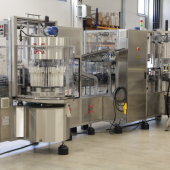Antisticking trays in bare aluminium
After cooking, the food now detaches from the trays with much greater ease. This is guaranteed
by the new product devised by Contital, developed and patented by Laminazione Sottile Group’s R&D department.
C. Sinagra, P. Pollice, S. Calise
The production of aluminium trays and lids used for cooking and storing food envisages the possibility of lubricating the rolled aluminium sheet before moulding the container.
Ministerial Decree 76 of April 18, 2007 [1] envisaged and regulated in Italy the use of this lubricant considered as “processing aid” in the manufacturing of such items.
The lubricants currently used are of vegetable or mineral origin, but must necessarily be approved by the Pharmacopoeia and be suitable for use in direct contact with food. [2-3-4].
The project idea - developed by the R&D department of Laminazione Sottile Group for the subsidiary Contital (a leading Italian company in the aluminium tray market) which patented it [5], was to use these lubricants as additives with a vegetable product approved in Europe as food additive: this latter is widely used in the food industry as “glazing agent” (i.e. substance used to coat candies), in order to obtain the release of food from the tray after cooking it.
Additive: characteristics and advantages
Figure 1 shows a picture of the anti-sticking agent in flakes, observed at the scanning electron microscope (SEM), before dispersing it into the lubricant used ad technological aid to mould the containers.
It is characterized by a particularly high melting point (82÷87 °C); this is the reason why it is much stiffer and thermally stable than other components, to which sometimes it is added to increase the melting point, hardness and strength of the product.
Its uses in the food industry are manifold: the product is used as a coating agent in confectionery products, nuts, coffee beans, but also as a polishing agent, especially in some types of particularly shiny candies as M&M’s®, Smarties®, Tic Tac®, Golia® Bianca, Fruittella®, in the Kimono long liquorice sticks of Haribo, as well as in Mentos®, BigBabol®, Full Fill and in some types of chocolates. It is also largely used in cosmetics (lipsticks, balms, creams, pencils, etc.) and in the pharmaceutical sector (for the coating of tablets, pills and capsules).
The European Food Safety Authority (EFSA) published its scientific opinion on this food additive in which it set also the ADI value (Acceptable Daily Intake) at 7 mg/kg of body weight per day [6].
In our tests we added the food additive in the oil used to lubricate the aluminium rolled sheet (which allows the moulding of the tray) up to 13%: the lubricant is laid at controlled temperature (855°C) so that, as soon as the oil touches the tape (which is at room temperature), the additive particles harden and get fixed on the metal. The systems used to lay the lubricant on the rolled sheet may be different and are all listed in the deposited Patent [5].
Normally the amount of lubricant laid on the aluminium sheet never exceeds 500 mg/m2 per side (grammage used only for smoothwall containers [7] with high drawing and critical geometry ratios; for wrinkle wall trays the amount of oil laid on the aluminium sheet normally does not exceed 200 mg/m2 per side).
It has already been observed that, already with around 10mg/m2 of additive, a thin and imperceptible layer of anti-sticking layer is formed on the aluminium sheet, which keeps on adhering to the metal surface even after the moulding of the tray: it ensures high anti-sticking properties with respect to the food item. A very small quantity of the additive remains on the container which has exceptional anti-sticking and “meat-release” properties and also improves resistance to the corrosion of metal in contact with food.
Furthermore, housewives may avoid the usual “practice” of greasing the tray with butter, margarine or various oils so as to ensure that food does not stick to the walls of the tray, thus avoiding their thermal degradation and the creation of unhealthy carbonaceous residues.
Hence there is the possibility of producing more dietetic food preparations, less rich in saturated fats and especially unsaturated fats (presence of double bonds in the carbon chain) harmful to health.
Tests on an industrial scale have enabled us to appreciate the advantages described in many sectors, mainly in “industrial baking” (croissants, muffins, pies, tarts, chocolate cakes, etc.), but also in the preparation of pies, flaky pastry and the production of bread and bakery products in general.
The additive is authorized in the EU as a food additive and as coating agent (Directive 95/2/ EC, Regulation (EC) No.1333 / 2008), even for dietary supplements, small bakery products coated with chocolate, snacks, nuts and coffee beans. The maximum amount allowed is 200 mg/kg of food. It is also authorized for surface treatment on citrus fruits, melons, apples and pears, and on peaches and pineapples, up to 200 mg/kg of food. In pastry making it can be used up to 500 mg/kg and on chewing gums up to 1,200 mg/kg.
The phases of the experiment
A sample of anti-sticking additive was subjected to a DSC test (Differential Scanning Calorimetry), which is the thermo-analytical method most used to get information on:
• characteristic temperatures (fusion, crystallization, polymorphic transitions, reactions, glass transitions);
• heat (enthalpy) of fusion, crystallization, transformation and reaction;
• oxidative stability (respectively OIT and OOT, temperature and oxidative induction time).
The OIT tests (oxidation induction time) are commonly used to study the oxidation resistance.
The DSC analysis was performed with scan up to 200 °C, in air environment and in nitrogen (flow 50 ml/min.); as shown in figure 2, no differences are recorded between the test in nitrogen and the test in air environment, thus confirming that there are no oxidative phenomena.
• With a view to evaluating the improvement of resistance to corrosion caused by the presence of lubricant admixed with anti-sticking, we performed potentiodynamic polarization measurements [8] in aqueous solution aerated at 3.5% by weight of NaCl.
They are the most traditional electrochemical measurements carried out in direct current (DC), which are used for the characterization and classification of metallic materials. These measurements allow to obtain the so-called potentiodynamic polarization curves through which it is possible to describe the behavior of the material under consideration in an object subjected to the corrosive action of an aggressive solution.
Various information about the nature and magnitude of the phenomena underway can be inferred from the analysis of potentiodynamic curves, such as
passivation, pitting and estimate of the corrosion rate of the material in aggressive environment.
Figure 3 shows the curves where it is possible to note, inter alia, the increase in the value of OCP (open circuit potential), a parameter indicating an increase in corrosion resistance.
Anti-sticking tests
With a view to evaluating the non-sticking properties of the food cooked in aluminium baking trays lubricated with oil containing the anti-sticking additive, several tests were performed with different types of food, comparing the results with respect to trays lubricated with standard oil.
By way of example,
We here show two cooking tests for croissant and omelette (figure 4 and figure 5).
Using the typical baking tray made for this purpose, the croissants were cooked at 180°C for 20’.
The croissants cooked in a baking tray lubricated by admixing the anti-sticking food additive (figure 4A) are released from the tray (even only by turning it upside down) without leaving residue either on the bottom or on the sides of the baking tray (as though occurs in figure 4B).
Since eggs are among the types of food which stick more to the baking tray, figure 5 shows the data regarding the cooking of omelettes. Also in this case the omelette is perfectly released from the tray where there is the anti-sticking agent admixed with oil. Conversely, in the tray with standard lubrication the omelette sticks to the bottom of the tray.
C. Sinagra
Laminazione Sottile SpA, R&D dpt., S. Marco Evangelista (CE)
P. Pollice, S. Calise
Contital srl, Pignataro Maggiore (CE)



















